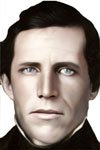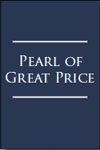| 1799 | 1835 | 1842 | 1844 | 1858 | 1860 | 1967 |
|---|---|---|---|---|---|---|
| Rosetta Stone discovered | Joseph begins translating Egyptian papyri | Translation published as Book of Abraham | Papyri sold after Joseph’s death | English translation of Rosetta Stone complete | Egyptologists identify Book of Abraham facsimiles as common funerary documents | LDS church reacquire papyri from the Met, NY. |
Introduction
In the summer of 1835, a traveling exhibit with Egyptian mummies came to Joseph Smith’s town. Inside the mummy coffins were two rolls and fragments of papyri.

On opening the coffins, he [Michael H. Chandler] discovered that in connection with two of the bodies, was something rolled up with the same kind of linen, saturated with the same bitumen, which, when examined, proved to be two rolls of papyrus, previously mentioned. Two or three other small pieces of papyrus, with astronomical calculations, epitaphs, &c., were found with others of the mummies. | |
 | — Joseph Smith
Mormonism founder
|
- Because Joseph claimed to have translated Reformed Egyptian to produce the Book of Mormon (Mormon 9:32) and claimed to be a seer (D&C 124:125)—one who can “translate all records that are of ancient date” (Mosiah 8:13)—he was asked to translate some characters from the papyri.

On the 3rd of July, Michael H. Chandler came to Kirtland to exhibit some Egyptian mummies. There were four human figures, together with some two or more rolls of papyrus covered with hieroglyphic figures and devices. As Mr. Chandler had been told I could translate them, he brought me some of the characters, and I gave him the interpretation. | |
 | — Joseph Smith
Mormonism founder
|
- Joseph Smith’s church bought the papyri and he identified the rolls as containing the writings of Abraham and Joseph.

Soon after this, some of the Saints at Kirtland purchased the mummies and papyrus, a description of which will appear hereafter, and with W. W. Phelps and Oliver Cowdery as scribes, I commenced the translation of some of the characters or hieroglyphics, and much to our joy found that one of the rolls contained the writings of Abraham, another the writings of Joseph of Egypt, etc.—a more full account of which will appear in its place, as I proceed to examine or unfold them. | |
 | — Joseph Smith
Mormonism founder
|
- Joseph published his translation of the ‘Abraham roll’ as the Book of Abraham. It was canonized in 1880 in the Pearl of Great Price.
- Mormons believe that the contents of the roll were written by Abraham’s own hand.

A Translation of some ancient Records that have fallen into our hands from the catacombs of Egypt. The writings of Abraham while he was in Egypt, called the Book of Abraham, written by his own hand, upon papyrus. | |
 | — Book of Abraham
Introduction
|

Joseph the Seer has presented us some of the Book of Abraham which was written by his own hand but hid from the knowledge of man for the last four thousand years but has now come to light through the mercy of God. | |
 | — Wilford Woodruff
Fourth Mormon prophet
|
- Since Abraham lived before Moses, who wrote the Torah—the first five books of the Old Testament—it would make the Abraham papyrus older than the book of Genesis.

It is evident that the writings of Abraham while he was in Egypt, of which our printed Book of Abraham is a copy, must of necessity be older than the original text of Genesis. | |
 | — Sidney B. Sperry
Mormon scholar
|
Verifying Joseph's Translation
If Joseph Smith’s translation of the papyri is accurate, it would confirm his claim that he possessed a supernatural gift. However, if his translation is wrong, then he is a fraud, and it would cast serious doubt on his other translation—the Book of Mormon.
- The discovery of the Rosetta Stone was the key to deciphering Egyptian hieroglyphics, and the English translation of the stone was completed in 1858. When Joseph began translating the papyri in 1835, there was no one to verify its accuracy.
- Published in the Book of Abraham are three facsimiles copied from the papyri along with Joseph’s interpretations of them.

Book of Abraham Facsimiles 1, 2 and 3 respectively
Independent Examinations
Over a dozen Egyptologists have examined the facsimiles. They all came to the same conclusion—Joseph Smith was ignorant of the Egyptian script. They have identified the papyri as common funerary documents belonging to the Book of the Dead, which is why the papyri were found in coffins.
- A Selection of Excerpts from Egyptologists
|
Sir W. M. Flinders Petrie Chair, Edwards Prof. of Egyptian Archaeology and Philosophy, Univ. College London |
I have examined the illustrations given in the 'Pearl of Great Price.' In the first place, they are copies (very badly done) of well known Egyptian subjects of which I have dozens of examples. Secondly, they are all many centuries later than Abraham.... the attempts to guess a meaning for them, in the professed explanations, are too absurd to be noticed. It may be safely said that there is not one single word that is true in these explanations.... none but the ignorant could possibly be imposed on by such ludicrous blunders. |
|
James Henry Breasted University of Berlin, Ph. D. Founder, Oriental Institute, Univ. of Chicago | These three fac-similes of Egyptian documents in the 'Pearl of Great Price' depict the most common objects in the mortuary religion of Egypt. Joseph Smith’s interpretation of them as part of a unique revelation through Abraham, therefore, very clearly demonstrates that he was totally unacquainted with the significance of these documents and absolutely ignorant of the simplest facts of Egyptian writing and civilization.... We orientalists could publish scores of these 'fac-similes from the Book of Abraham' taken from other sources. |
|
Samuel Alfred Browne Mercer
Prof. of Semitic Languages and Egyptology, Univ. of Toronto Trinity College | The author knew neither the Egyptian language nor the meaning of the most commonplace Egyptian figures.... it may be remarked that his explanations from a scientific and scholarly standpoint are absurd.... the explanatory notes to his fac-similes cannot be taken seriously by any scholar, as they seem to be undoubtedly the work of pure imagination. |
|
Richard Anthony Parker
Prof. of Egyptology, Univ. of Chicago. Founder, Dept. of Egyptology, Brown Univ. Founding Trustee, American Research Center in Egypt | The explanations are completely wrong insofar as any interpretation of the Egyptian original is concerned. |
|
Friedrich W. von Bissing
Prof. of Egyptology, Univ. of Munich | What he calls the 'Book of Abraham' is a funeral Egyptian text, probably not older than the Greek ages.... Jos. Smith certainly never got a Divine revelation in the meaning of the ancient Egyptian Script, and that he never deciphered hieroglyphic texts at all. |
|
Rev. Dr. John Punnett Peters
Prof. of Semitics, Univ. of Pennsylvania | The plates contained in the 'Pearl of Great Price' are rather comical and a very poor imitation of Egyptian originals.... The text of this chapter, as also the interpretation of the plates, displays an amusing ignorance. Chaldeans and Egyptians are hopelessly mixed together, although as dissimilar and remote in language, religion and locality as are today American and Chinese. In addition to which the writer knows nothing of either of them. |
|
Archibald Henry Sayce
Prof. of Assyriology, Oxford | It is difficult to deal seriously with Joseph Smith's impudent fraud.... I need scarce say that Kolob, etc., are unknown to the Egyptian language.... Smith has turned the Goddess into a king and Osiris into Abraham. |
|
Arthur C. Mace
Asst. Curator, Metropolitan Museum of Art, Dept. of Egyptian Art, New York | The 'Book of Abraham,' it is hardly necessary to say, is a pure fabrication. Cuts 1 and 3 are inaccurate copies of well known scenes on funeral papyri, and cut 2 is a copy of one of the magical discs.... Joseph Smith's interpretation of these cuts is a farrago of nonsense from beginning to end. Egyptian characters can now be read almost as easily as Greek, and five minutes' study in an Egyptian gallery of any museum should be enough to convince any educated man of the clumsiness of the imposture. |
|
Eduard Meyer
Prof. of Ancient History, Humboldt Univ. of Berlin | The Egyptian papyrus which Smith declared to be the 'Book of Abraham,' and 'translated' or explained in his fantastical way, and of which three specimens are published in the 'Pearl of Great Price,' are parts of the well known 'Book of the Dead'. |
|
John Albert Wilson
Prof. of Egyptology, Univ. of Chicago | From the standpoint of the Egyptologist the explanations given with these illustrations are incorrect. The Egyptian language on such documents is decipherable and has appeared in translation in various books. |






